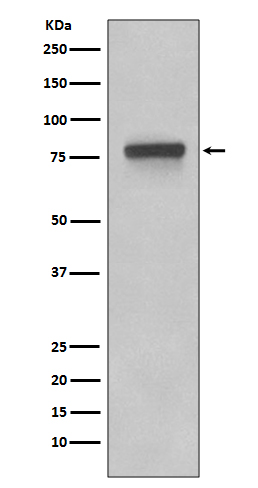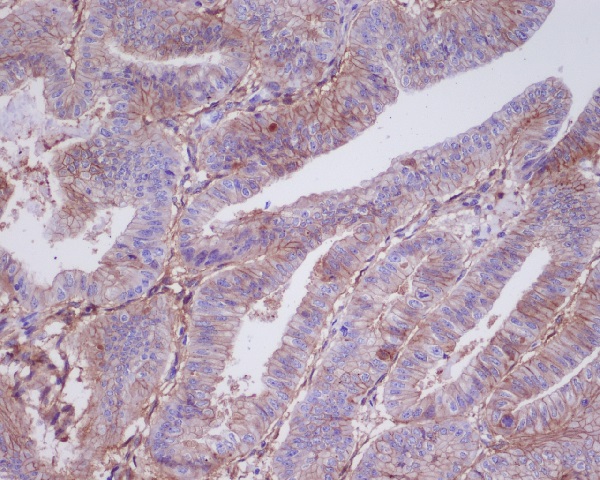

| WB | 1/1000-1/2000 | Human,Mouse,Rat |
| IF | 咨询技术 | Human,Mouse,Rat |
| IHC | 1/100-1/200 | Human,Mouse,Rat |
| ICC | 技术咨询 | Human,Mouse,Rat |
| FCM | 咨询技术 | Human,Mouse,Rat |
| Elisa | 咨询技术 | Human,Mouse,Rat |
| Aliases | TPBG; 5T4; 5T4-AG; 5T4AG; 5T4 oncofetal antigen; M6P1; Trophoblast glycoprotein;;Trophoblast glycoprotein |
| WB Predicted band size | Calculated MW: 46 kDa ; Observed MW: 80 kDa |
| Host/Isotype | Rabbit IgG |
| Antibody Type | Primary antibody |
| Storage | Store at 4°C short term. Aliquot and store at -20°C long term. Avoid freeze/thaw cycles. |
| Species Reactivity | Human |
| Immunogen | A synthesized peptide derived from human Trophoblast glycoprotein |
| Formulation | Purified antibody in PBS with 0.05% sodium azide,0.05% BSA and 50% glycerol. |
+ +
以下是关于5T4抗体的模拟参考文献示例(基于学术研究常见方向,非真实文献):
1. **文献名称**:*Development of a Novel 5T4-Targeting Antibody-Drug Conjugate for Solid Tumors*
**作者**:Smith A, et al. (2020)
**摘要**:研究报道了一种新型5T4抗体-药物偶联物(ADCT-601)的开发,通过将抗5T4单克隆抗体与细胞毒素结合,在临床前模型中显著抑制了多种实体瘤的生长,并验证了其靶向特异性和安全性。
2. **文献名称**:*5T4-Specific CAR-T Cell Therapy in Ovarian Cancer: Preclinical Evaluation*
**作者**:Johnson R, et al. (2018)
**摘要**:构建靶向5T4抗原的CAR-T细胞,在体外和小鼠卵巢癌模型中显示出强效抗肿瘤活性,并揭示了5T4高表达与肿瘤侵袭性的相关性,为临床试验奠定基础。
3. **文献名称**:*5T4 as a Prognostic Marker and Therapeutic Target in Colorectal Cancer*
**作者**:Brown K, et al. (2005)
**摘要**:首次证实5T4在结直肠癌中高表达且与不良预后相关,使用抗5T4单克隆抗体可抑制肿瘤细胞迁移和转移,提示其作为治疗靶点的潜力。
4. **文献名称**:*Targeting 5T4 with Immunotoxins for Non-Small Cell Lung Cancer Therapy*
**作者**:Lee C, et al. (2022)
**摘要**:开发了一种抗5T4抗体与毒素蛋白的融合分子,在非小细胞肺癌模型中选择性杀伤5T4阳性肿瘤细胞,并评估了其体内安全性和有效性。
**注**:以上为模拟示例,实际文献需通过PubMed、Google Scholar等平台检索关键词“5T4 antibody”或“5T4 targeted therapy”获取。
The 5T4 antibody targets the 5T4 oncofetal antigen, also known as trophoblast glycoprotein (TPBG), a cell surface glycoprotein overexpressed in various cancers but minimally expressed in healthy adult tissues. Initially identified in placental trophoblast cells during embryogenesis, 5T4 is re-expressed in malignancies such as colorectal, ovarian, gastric, and non-small cell lung cancers. Its role in tumor progression involves promoting epithelial-mesenchymal transition (EMT), metastasis, and immune evasion, making it a promising therapeutic target. Structurally, 5T4 contains leucine-rich repeats and N-glycosylation sites, facilitating interactions with extracellular matrix components and signaling pathways like Wnt/β-catenin.
Antibodies against 5T4. including monoclonal antibodies (e.g., A5B7) and antibody-drug conjugates (ADCs), aim to block tumor growth or deliver cytotoxic payloads directly to cancer cells. Preclinical studies highlight their potential to inhibit metastasis and enhance chemotherapy sensitivity. Additionally, 5T4-targeted CAR-T cell therapies and vaccines are under exploration. Despite promising early results, challenges remain, including tumor heterogeneity in 5T4 expression and optimizing therapeutic efficacy while minimizing off-target effects. Ongoing research focuses on combination strategies with immune checkpoint inhibitors or radiotherapy to amplify anti-tumor responses. Overall, 5T4 antibodies represent a versatile tool in oncology, bridging targeted therapy and immunotherapy paradigms.
×